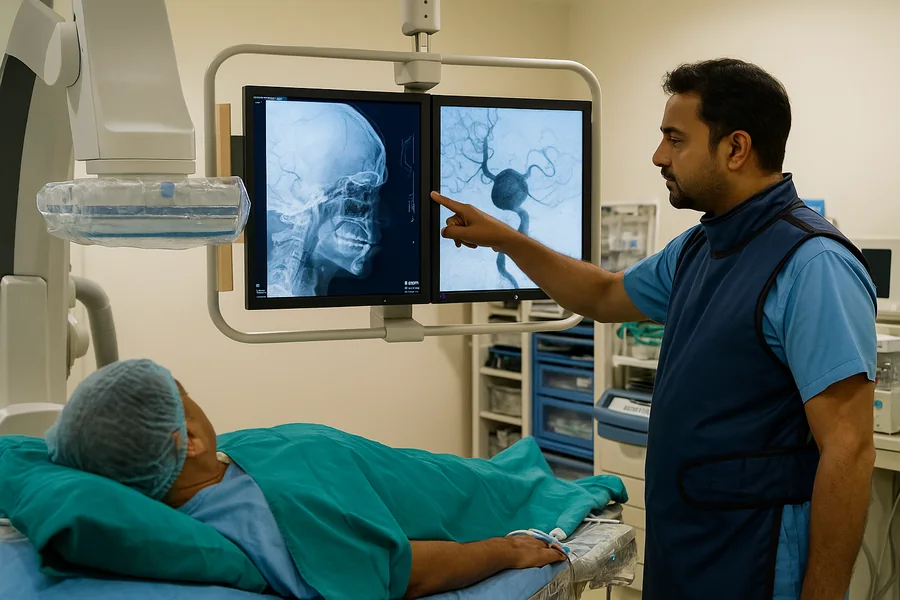
Aneurysm Surgery (Brain Aneurysm Clipping) in Noida
By Dr. P. K. Jha — Senior Neurosurgeon • Brain & Vascular Microsurgery
Brain aneurysm is a weak, bulging spot in a brain artery. If it ruptures, it can cause a life-threatening subarachnoid hemorrhage (SAH). Selected unruptured aneurysms are also treated to prevent future bleeding. At Neuro Care India (Noida), Dr P K Jha provides microsurgical clipping and co-manages endovascular options with partner centers based on anatomy, risk and patient preference.
Symptoms & Red Flags
- Sudden, severe “worst” headache (thunderclap) ± vomiting, neck stiffness — medical emergency.
- Loss of consciousness, seizures, double vision, drooping eyelid, one-sided weakness/numbness.
- Unruptured aneurysm may cause local headache, cranial nerve palsy or may be incidental on MRI/CT.
How We Diagnose
- CT Brain to detect bleed (SAH) quickly.
- CT Angiography (CTA) or MR Angiography (MRA) to visualize aneurysm size, neck and branches.
- DSA (Digital Subtraction Angiography) when anatomy is complex or before definitive treatment.
Treatment Options & How We Choose
Choice depends on patient age, clinical grade, aneurysm location/neck width, presence of bleed, and feasibility at our partner centers.
- Microsurgical Clipping — via small craniotomy; aneurysm neck is closed with a titanium clip. Offers durable occlusion, especially for MCA/bifurcation/ wide-neck aneurysms. Performed by Dr Jha.
- Endovascular Coiling / Flow-Diverter Stent — catheter-based treatment performed in hybrid/cath labs; co-managed with endovascular teams when better suited (e.g., posterior circulation, narrow neck, high surgical risk).
What to Expect with Clipping
- Pre-op optimization: labs, anesthesia fitness, blood pressure control, DVT and vasospasm prevention plan.
- Microsurgery: neuronavigation, micro-instruments, temporary clips when needed; ICG/Doppler to confirm flow.
- ICU care: close neuro-monitoring, electrolytes, vasospasm surveillance, pain control.
- Recovery: ward transfer in 24–48h if stable; sutures off ~7–10 days; return to desk work in 2–4 weeks (individualized).
Risks & Outcomes
With timely care, many patients make good recovery. Risks include re-bleed, vasospasm-related deficits, stroke, infections, seizures or hydrocephalus. Your individualized risk is explained after imaging review.
Costs, Insurance & Hospital Tie-ups
We admit patients according to budget and preference across multiple hospitals in Delhi & Noida. Estimates vary by ICU stay, implants (clip sets, stents/flow diverters), and room choice. Share your reports; we’ll give a transparent estimate and available options.
When Should You Rush to Hospital?
- Thunderclap headache or sudden collapse.
- New focal weakness, seizures, repeated vomiting, profound drowsiness.
- Known aneurysm with new severe headache or neuro-deficit.
FAQ
Enquiry form
Call ambulance, bring previous records and arrive at the nearest partner hospital. Parallel ICU & OT activation is coordinated by our team.